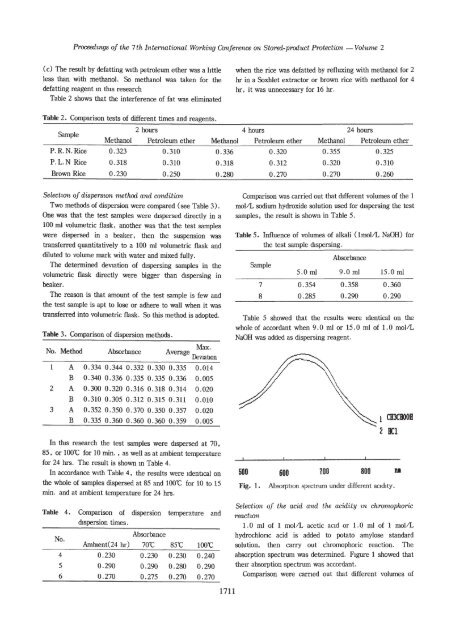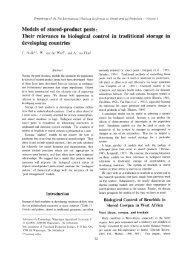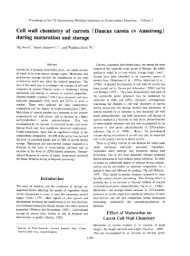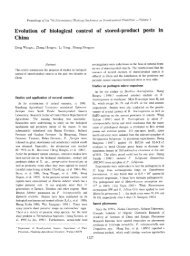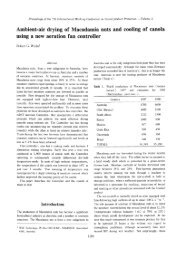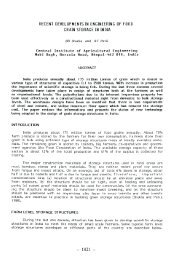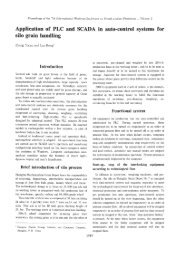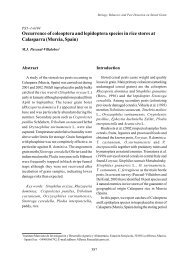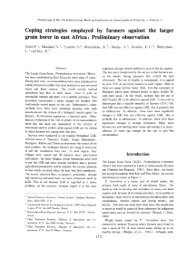Research on method for determination of amylose content in rice
Research on method for determination of amylose content in rice
Research on method for determination of amylose content in rice
You also want an ePaper? Increase the reach of your titles
YUMPU automatically turns print PDFs into web optimized ePapers that Google loves.
Proceedmqe <strong>of</strong> the 7 th Internati<strong>on</strong>al Work<strong>in</strong>g C<strong>on</strong>ference <strong>on</strong> Stored-product Protecti<strong>on</strong> - Volume 2<br />
(c) The result by defatt<strong>in</strong>g WIth petroleum ether was a httle<br />
less than with methanol. So methanol was taken <strong>for</strong> the<br />
defatt<strong>in</strong>g reagent In this research<br />
Table 2 shows that the <strong>in</strong>terference <strong>of</strong> fat was elim<strong>in</strong>ated<br />
Table 2. Comparis<strong>on</strong> tests <strong>of</strong> different times and reagents.<br />
Sample<br />
P.R.N.Rice<br />
P.L.N Rice<br />
Brown Rice<br />
Methanol<br />
0.323<br />
0.318<br />
0.230<br />
2 hours<br />
Petroleum ether<br />
0.310<br />
0.310<br />
0.250<br />
Selectum <strong>of</strong> dispereum. <strong>method</strong> and c<strong>on</strong>diti<strong>on</strong><br />
Two <strong>method</strong>s <strong>of</strong> dispersi<strong>on</strong> were compared (see Table 3) .<br />
One was that the test samples were dispersed directly <strong>in</strong> a<br />
100 ml volumetric flask, another was that the test samples<br />
were dispersed <strong>in</strong> a beaker, then the suspensi<strong>on</strong> was<br />
transferred quantitatively to a 100 ml volumetric flask and<br />
diluted to volume mark with water and mixed fully.<br />
The determ<strong>in</strong>ed deviati<strong>on</strong> <strong>of</strong> dispers<strong>in</strong>g samples <strong>in</strong> the<br />
volumetric<br />
beaker.<br />
flask directly were bigger than dispers<strong>in</strong>g <strong>in</strong><br />
The reas<strong>on</strong> is that amount <strong>of</strong> the test sample is few and<br />
the test sample is apt to lose or adhere to wall when it was<br />
transferred <strong>in</strong>to volumetric flask. So this <strong>method</strong> is adopted.<br />
Table 3. Comparis<strong>on</strong> <strong>of</strong> dispersi<strong>on</strong> <strong>method</strong>s.<br />
No. Method Absorbance Average<br />
Max.<br />
De<br />
vian<strong>on</strong><br />
1 A 0.334 0.344 0.332 0.330 0.335 0.014<br />
B 0.340 0.336 0.335 0.335 0.336 0.005<br />
2 A 0.300 0.320 0.316 0.318 0.314 0.020<br />
B 0.310 0.305 0.312 0.315 0.311 0.010<br />
3 A 0.352 0.350 0.370 0.350 0.357 0.020<br />
B 0.335 0.360 0.360 0.360 0.359 0.005<br />
In this research the test samples were dispersed at 70,<br />
85, or 100'C <strong>for</strong> 10 m<strong>in</strong>. , as well as at ambient temperature<br />
<strong>for</strong> 24 hrs. The result is shown In Table 4.<br />
In accordance WIth Table 4, the results were Identical <strong>on</strong><br />
the whole <strong>of</strong> samples dispersed at 85 and 100°C <strong>for</strong> 10 to 15<br />
m<strong>in</strong>. and at ambient temperature <strong>for</strong> 24 hrs.<br />
Table 4. Comparis<strong>on</strong> <strong>of</strong> dispersi<strong>on</strong> temperature and<br />
dispersi<strong>on</strong> times.<br />
No.<br />
Ambientt 24 hr)<br />
Absorbance<br />
70'C 85'C 100'C<br />
4 0.230 0.230 0.230 0.240<br />
5 0.290 0.290 0.280 0.290<br />
6 0.270 0.275 0.270 0.270<br />
when the <strong>rice</strong> was defatted by reflux<strong>in</strong>g with methanol <strong>for</strong> 2<br />
hr <strong>in</strong> a Soxhlet extractor or brown <strong>rice</strong> with methanol <strong>for</strong> 4<br />
hr , it was unnecessary <strong>for</strong> 16 hr.<br />
Methanol<br />
4 hours<br />
Petroleum ether<br />
0.336<br />
0.318<br />
0.280<br />
1711<br />
0.320<br />
0.312<br />
0.270<br />
Methanol<br />
24 hours<br />
Petroleum ether<br />
0.355<br />
0.320<br />
0.270<br />
0.325<br />
0.310<br />
0.260<br />
Comparis<strong>on</strong> was carried out that different volumes <strong>of</strong> the 1<br />
mollL sodium hydroxide soluti<strong>on</strong> used <strong>for</strong> dispers<strong>in</strong>g the test<br />
samples, the result is shown <strong>in</strong> Table 5.<br />
Table 5. Influence <strong>of</strong> volumes <strong>of</strong> alkali (Imol/L NaOH) <strong>for</strong><br />
the test sample dispers<strong>in</strong>g.<br />
Sample<br />
7<br />
8<br />
Absorbance<br />
5.0 ml 9.0 ml 15.0 ml<br />
0.354<br />
0.285<br />
0.358<br />
0.290<br />
0.360<br />
0.290<br />
Table 5 showed that the results were Identical <strong>on</strong> the<br />
whole <strong>of</strong> accordant when 9.0 ml or 15.0 ml <strong>of</strong> 1.0 mollL<br />
NaOH was added as dispers<strong>in</strong>g reagent.<br />
500 100 800<br />
600<br />
Fig. 1. Absorpti<strong>on</strong> spectrum under different acidity,<br />
1 CH3CROOB<br />
2 11:1<br />
Selecti<strong>on</strong> <strong>of</strong> the acid and<br />
reaciuni<br />
the acidity m. chrorrwphoric<br />
1 .0 ml <strong>of</strong> 1 mol/L acetic acid or 1.0 ml <strong>of</strong> 1 mol/L<br />
hydrochloric acid is added to potato <strong>amylose</strong> standard<br />
soluti<strong>on</strong>, then carry out chromophoric reacti<strong>on</strong>. The<br />
absorpti<strong>on</strong> spectrum was determ<strong>in</strong>ed. FIgure 1 showed that<br />
their absorpti<strong>on</strong> spectrum was accordant.<br />
Comparis<strong>on</strong> were carried out that different volumes <strong>of</strong>


